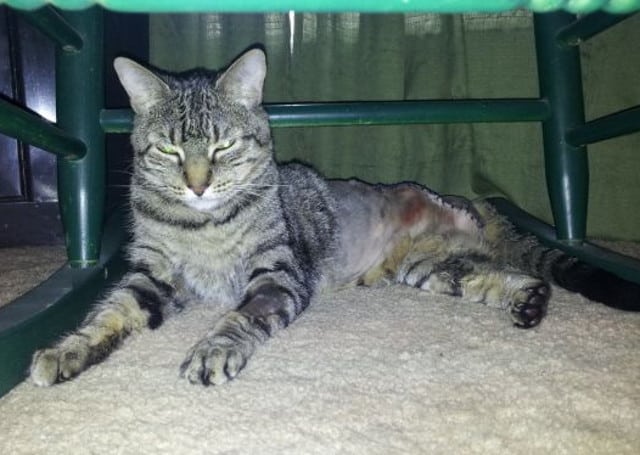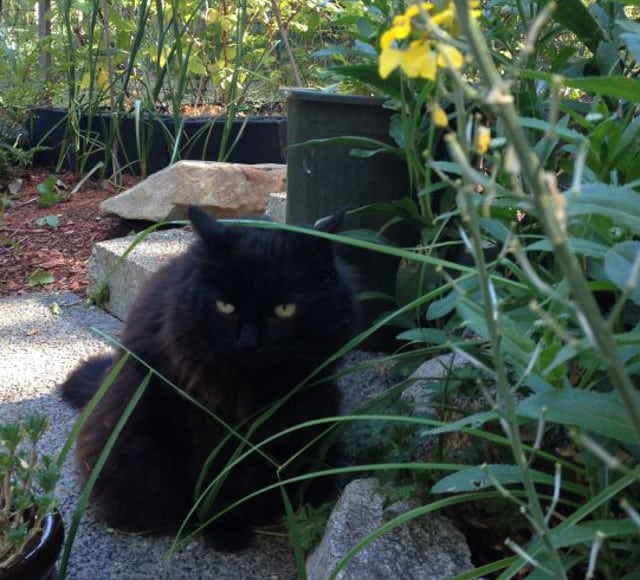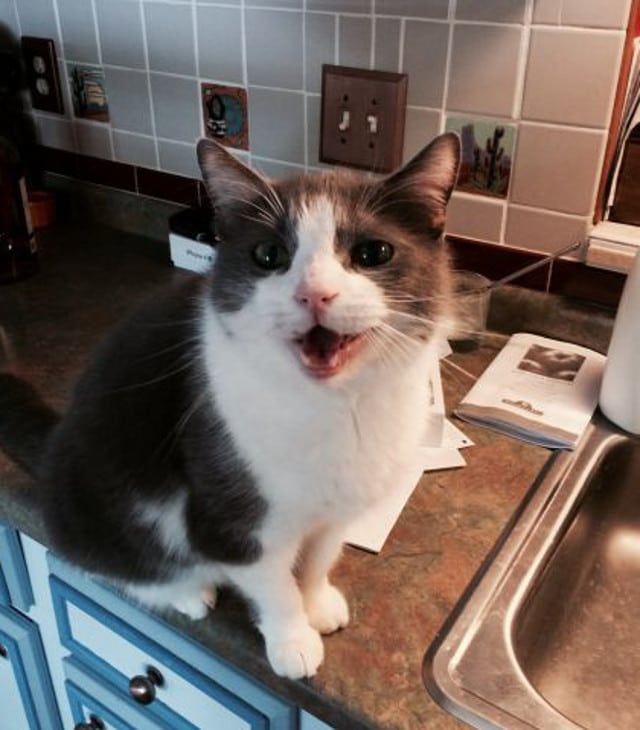Vaccine Associated Sarcoma (VAS) in cats is supposed to be a rare cancer. But it’s not unheard of in the Tripawds Nation. You may have also heard it called “Feline Injection-site Sarcoma” (FISS). Unfortunately many feline Tripawds members lost a leg to this tumor. Today we’ll tell you about them, and share information about VAS / FISS tumors in cats.
Meet Vaccine Associated Sarcoma Cats / Feline Injection Site Sarcoma Cats
Today we’re sharing some VAS cat stories, then read on because you’ll also find more helpful information about VAS.
Little Man
Little Man has a great blog called “Little Man: Loving Life on Three Legs.” It’s one of the first Tripawd kitty blogs discussing Vaccine Associated Sarcoma and how he coped after amputation.

Back in May of 2012, my mom found a lump on my left hind leg. She took me to my vet and he did a wedge biopsy. The tumor was a vaccine-associated fibrosarcoma (VAS). He went over all the research with my mom and told her that amputation was my best chance at beating this thing. — Introducing Little Man
Mona
After Little Man came TriKitty Mona. Her mom Kerren teaches us so much about this stubborn cancer in cats. She is an active member of this community, and Kerrin always lends a helping paw to cats and dogs alike. No matter the diagnosis, Mona and Kerren offer helpful tips whenever they can.

In her blog post, One Year Later – What I’ve Learned, she writes:
Vaccine Associated Fibrosarcomas in cats is not curable. Hopefully tumour removal through surgery stops it from spreading. Radiation, chemo, and Interleukin 2 only delay re-occurrence. If possible immediate amputation is the best hope to rid the body of VAS if the vaccines are injected low in the leg. My vet and pathologist are confident the cancer left with the leg. All I have is hope. I don’t dwell on it but am thankful for every day she is with me.
Jerry
Another Tripawd cat with VAS was Jerry. This sweetie’s blog “Three Cats, Eleven Paws” is also filled with helpful insight about coping with a probable VAS tumor. The cancer appeared not once, but multiple times. Eventually it took his life, but his spirit lives on and stays strong.

where the cancer erupted on Jerry, we figured it was not brought on by a vaccination. My vets have a protocol as to where on the animal they will give the vaccination. The cancer erupted on the area of the foot that is equivalent to an ankle in a human. The oncologist I worked with with the radiation therapy when the cancer first showed up said he’d be extremely impressed if any vet could get a vaccination in at the site. The oncologist told me this cancer can also just erupt without a vaccination. — Dealing with a Diagnosis of Cancer
Within the vet community there still seems to be a lot of guesswork when it comes to Vaccine Associated Sarcoma in cats. Here’s what science knows for sure:
Basic Facts About VAS or FISS
According to this helpful information from the University of Florida Small Animal Hospital:
- VAS sarcomas are tumors formed within a cat’s connective tissues. These tumors are usually “fibrosarcomas,” named after the cells found within the tumor.
- VAS tumors occur at vaccination sites; shoulder blades, hips and back legs.
- Certain vaccines, including rabies and feline leukemia are linked to this cancer.
- Genetic predisposition could play a role, but scientists don’t know exactly how.
- Surgical excision is the best way to remove the tumor, but these tumors have many “tentacles” that are difficult to remove.
- Cats with VAS leg tumors have the best odds for beating the cancer.
- Chemotherapy and radiation increase longveity odds of up to 24 month survival time.
- Regardless of treatment, metastasis happens about 10-25 percent of the time.
Information about Vaccine Associated Sarcomas (Feline Injection Site Sarcomas) in cats is growing but there’s still much work to be done to find a cure for this type of cat cancer. Like many pet cancers, researchers aren’t quite sure how to prevent it other than advising to “vaccinate discriminately.” When cats do get vaccinated, University of Florida experts advise:
Vaccination on the lower limbs and tail has been advocated, such that amputation of the affected leg or tail can be performed if a tumor should occur.
Recommended Reading: Vaccine Associated Sarcoma Cats / Feline Injection Site Sarcomas in Cats
If you came here for reputable information about VAS / FISS, we hope this helps. Join the Tripawds Discussion Forums for support, and check out these helpful, science-based articles about VAS that we’ve located for you:
- American Animal Hospital Assocation 2020 Feline Vaccination Guidelines: Update on Feline Injection-Site Sarcomas
- American Veterinary Medical Association: Vaccines and Sarcomas, a Concern for Cat Owners
- DVM360: Vaccine-associated Sarcomas in Cats
- CatHealth.com: Vaccine Associated Sarcomas in Cats
- National Institutes of Health: Feline Postvaccinal Sarcoma, 20 years Later
- Veterinary Cancer Group: Vaccine Associated Sarcomas in Cats(PDF Download)
- Dennis W. Macy DVM, MS, DACVIM, Professor Emeritus, Colorado State University: Feline Vaccine Associated Sarcoma (PDF Download)
- Got other good articles about VAS in cats that you’d like to share? Comment below and let us know where to locate them. We’ll be sure to add them to this list.

Thanks for sharing this important information for those with cats, or those who have feline friends. As usual it’s a well researched and written blog.
Kerren
Oh my gosh Kerren thank YOU. And you know what? I forgot to link to a REALLY great response you gave in the Forums about what to do if a VAS tumor is confirmed. It was probably over a year ago. Any idea where it is? I just spend 15 minutes looking and couldn’t find it. No worries if you can’t either. Thanks for all you do!
Thank you for sharing. Very interesting read.
Thanks Michelle. We learn so much from TriKitties don’t we?!